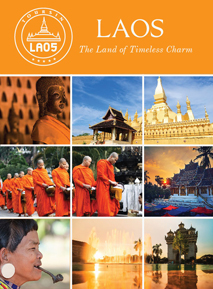Quick Facts:
- Location: southwestern Laos, bordering Thailand and Cambodia
- Population: 598.339 people (estimated 2005)
- Area: 15,410 square kilometers
- One of the most visited provinces of Laos
- Abundant of attractive landscape such as Wat Phu temple; Khone Phapheng and Phasom water fall
- 4,000 small islands
Champasak - a province in southwest is one of the largest rice baskets of Laos. Champasak is a tourist attraction address with many famous scenic spots such as: the WatPhou temple - the world's cultural heritage, Khone and Phapheng - largest waterfall in Southeast Asia, the ancient temples bearing Angkor architecture...
Pakse is the capital city of the province of Champasak. On the map, Pakse looks like a jutting- out promontory which is embraced by two rivers, Sedon in the north and the Mekong in the South. Pakse means "river city".
Buddhism holds an important position in the minds and lives of Laos. Like other parts of the country's major festivals take place in Champasakthroughout the year such as: WatPhouFestival in February, Phase VeatFestival in March, Pi Mai Lao Festival in April, Bang PhaiFestival inMay,KhaoPhan Sa Festival in June, sailing ceremony in October ...
Every morning, the monks walk along the city street for traditional rite of Almsgiving. The temples have curved roofarchitecture, a bright gilded by the light of the sun. Around each temple, hundreds of small tower called vats which contain the bones and ashes of death people) make into a fence. Design of vatsis diversified, colorful…
The most typical culture building of Champasak is the sacred temple of WatPhou - the world's cultural heritage. Located about 40km far from the South of Pakse, along the Mekong River, WatPhou from the 9th to the 13th century is considered one of the most sacred temples of the ancient kingdom in this land.
From the South of WatPhou about 1 km is the ancient temples such as Nandin, Nang Sida. The other side of the Mekong River is temple Oubmong. Besides, Champasak owns "a jewel" - the Khone Falls Phapheng–the largest waterfall in Southeast Asia which connect the two shores of the Mekong River withChampasak and Strung Treng province of Cambodia.
As coming here, you really understand why KhonePhapheng is known as the "Niagara of the Asia". Although water walls are not as vertical and high as Niagara, but falls have a length of 12km and there is always a huge amount of water filled with sediment flowing over a large surface with many jagged rocks.
The low-water season, between March and May, there are about 4,000 islands knobbing on the river. Here, visitors can watch the locals fishing, or rent a boat to watch dolphins growling waves or lie on coastal rocks to listen waterfall roaring…

























































